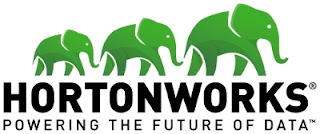With the increasing prevalence of Internet of Things and the
Digital Transformation of businesses, the amount of data collected is said to
increase exponentially in the coming years. In Asia Pacific, some forecasters
see that automation will remain a high focus point in most of its economies. Of
course, it is inevitable that Big Data and Big Data Analytics is slowly taking
its ground in the region.
Digital Transformation of businesses, the amount of data collected is said to
increase exponentially in the coming years. In Asia Pacific, some forecasters
see that automation will remain a high focus point in most of its economies. Of
course, it is inevitable that Big Data and Big Data Analytics is slowly taking
its ground in the region.
John Kreisa, Vice President, International Marketing from Hortonworks will give us an insight on the topic of the rise of Big Data.
 |
| John Kreisa Vice President, International Marketing Hortonworks |
1. What are some of the key problems that you think Big Data can solve in the APAC region?
I think big data has tremendous opportunity for organisations and governments in Asia. What we would typically say is that every business is a data business. So if you look at specific industries like retail, big data offers them the opportunity to capture all of the interactions that they have with their customers and create a more intimate interaction with these customers.
Knowing how they interact with them socially, how they interact with them online and how they interact amongst stores with how the purchase histories are collecting all that big data together, integrating it gives them a 360 degree view of their customer and allows them to do a better job of making offers and addressing any issues that might come up. Similarily if you look at other issues such as financial services, they also will use it for a wide range of applications including things like cybersecurity. It offers them the ability to capture and look at patterns in history of usage of account and potential cyber threats.
Organisations can collect all of that data and look for patterns deep within the data.It also offers them the ability to get more intimate with their customers by collecting valuable insights across their online journey such as the way they interact online. These insights can be used to better the customer experience within their facilities, through the loans and through the banking accounts and all the other ways they might interact with their customers. These insights allows them to have a more intimate interaction with those customers.
Similarly, in manufacturing, insurance and government as well. All these different areas can benefit from using big data technologies to create new applications. They have the ability to transform a business and build new business application and create new opportunities.
2. What sort of returns are larger corporations seeking for when putting their investments in big data analytics?
We typically see organisations investing in two patterns. One is for renovating their existing architecture. And that’s to create additional operational efficiencies from their legacy systems they are currently using so they are able to capture and store data and keep it online for a much longer time at a much lower cost.
This really helps organisations get a deeper insight into the data that they already have, so first thing they are renovating their overall infrastructure to create operational efficiencies. Now once they do that they in turn start to create new innovative ways that they are starting to use the data and they are innovating their business and transforming their business in the areas of data discovery.
This helps them understand more about their customers or predictive analytics help them look forward and understand pre-transactions before they ever interact with a customer. So they are investing to create new applications and driving business opportunities and those are the kinds of returns they are looking for.
Saving money and then using those savings to create new business opportunities. The investments are definitely reproducing, our customers have very strong returns in investment and cost savings and from the new applications that they are creating new business areas. They are able to do that because they capture all that data and they can do productive commitments and they offer a new service. So it really gives them the ability to drive new big data across the organisation.
3. Do you think these investments will be worth it?
Absolutely. I think we have already seen organisations who have invested heavily on technology and see positive returns.
Again, in the areas of cost savings and the new business models and increase customer intimacy we got retailers, and banks increase engagement with their customers with new applications and new offers that they are selling so there’s no doubt that the investments have been worth it. The organisations and the technology from an organisational standpoint and technology standpoint where organisations will really see the benefits.
4. What do you think are the challenges to big data analytics?
Big data technologies require new skill sets in order to maximize the value. For example people trained in data science techniques to analyze data to find new business opportunities and efficiencies.
So access to the right set of skills is a challenge that is being addressed by companies like Hortonworks. Secondly, there is sometimes organisational resistance to new technology. Significant investments have been made in the existing architectures and people have tied their careers to these technologies. That creates some friction and internal resistance.
We often hear that is one of the bigger challenges and it takes a st
rong internal visionary to push an organisation in the right direction. Hortonworks recognizes those individuals through our Hortonworks Heroes program.
5. What do you see in the future of big data analytics?
The Industrial internet of things is one of the huge drivers of these technologies and leading manufacturers are already putting these technologies in place.
They can now capture and analyze all of the data that comes from their machines to look for even the smallest anomaly that might indicate that there is a problem. They can also capture data after a part or device has left the factory to analyse wear patterns, breakdowns and defects to improve their manufacturing process. This is extremely valuable for improving the overall manufacturing process.
We will continue to invest and expand in order to address the multi-billlion dollar opportunity represented by big data. We focus on customer success and that is one of the reasons we have grown so fast. In fact we were the fastest growing enterprise software company to $100m in revenue ever! We recently opened an office in Singapore as our APAC HQ and should see significant growth going forward.
John Kreisa, VP International Marketing, Hortonworks
A veteran from the enterprise marketing industry, John has worked at companies with products at every level of the IT stack from scale-out storage through to the insight of business intelligence and analytics. Based in London, John leads International Marketing at open source leader Hortonworks who develops, distributes and supports connected data platforms for maximising the value of data across the enterprise.
About Hortonworks
Hortonworks is an industry leading innovator that creates, distributes and supports enterprise-ready open data platforms and modern data applications that deliver actionable intelligence from all data: data-in-motion and data-at-rest. Hortonworks is focused on driving innovation in open source communities such as Apache Hadoop, NiFi and Spark. Along with its 1,600+ partners, Hortonworks provides the expertise, training and services that allow customers to unlock transformational value for their organizations across any line of business.
Hortonworks, HDP and HDF are registered trademarks or trademarks of Hortonworks, Inc. and its subsidiaries in the United States and other jurisdictions. For more information, please visit www.hortonworks.com. All other trademarks are the property of their respective owners.
For the LATEST tech updates,
FOLLOW us on our Twitter
LIKE us on our FaceBook
SUBSCRIBE to us on our YouTube Channel!






